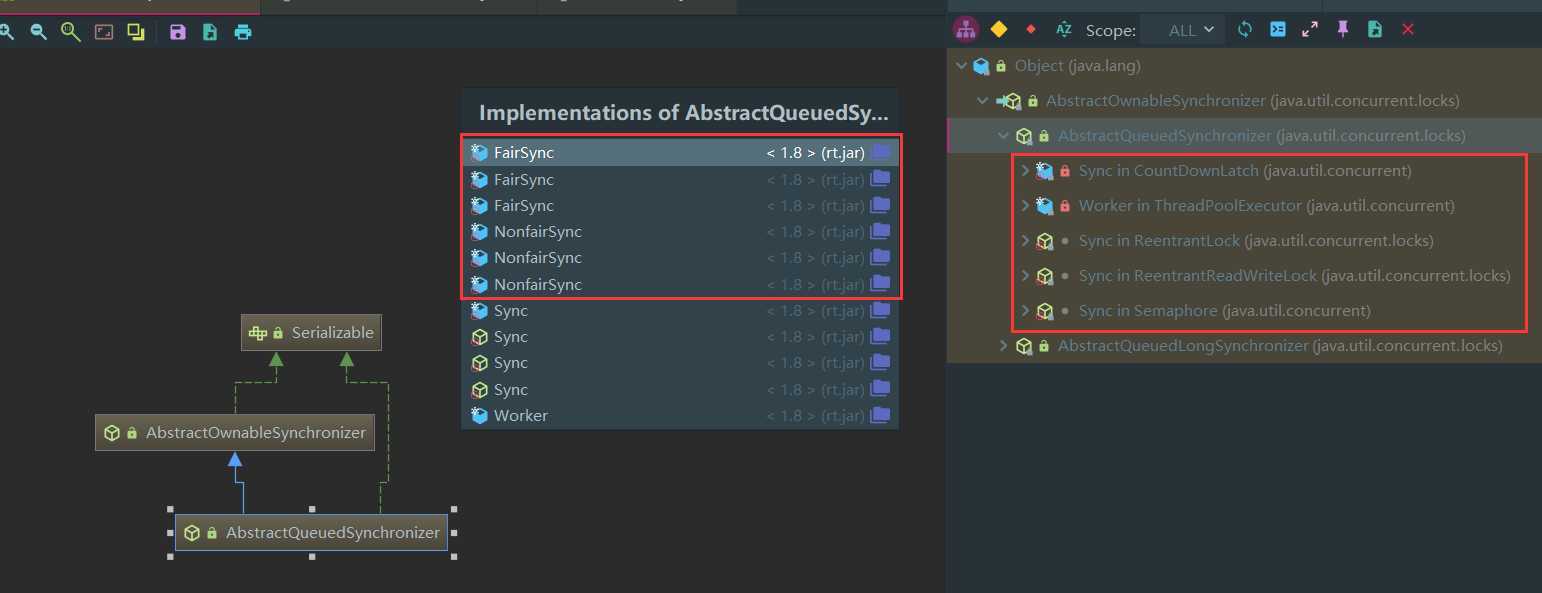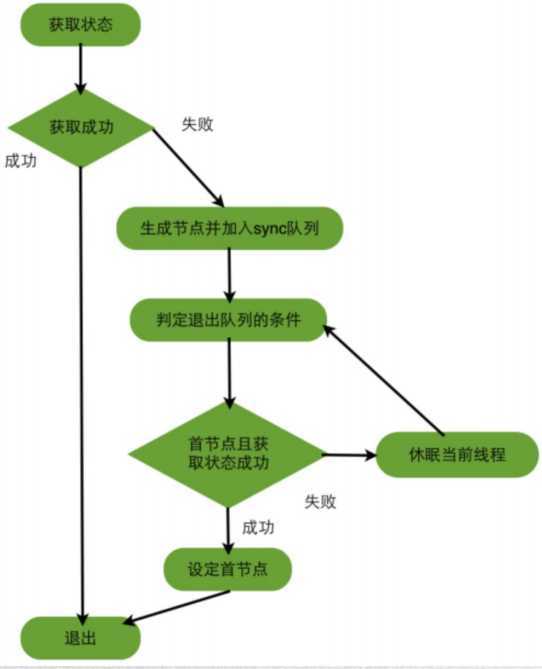上一节学习到的ThreadPoolExecutor在并发编程中更为适用,故知己知彼方能百战不殆,这次的学习目的只要有如下几个:
1、了解源码,能更加灵活使用线程池
2、看看大神是如何设计一个线程池的
话说了解ThreadPoolExecutor的话,为啥又要说道AbstractOwnableSynchronizer呢。
因为线程池中的线程有点特殊,它们都是AQS的子类(AbstractQueuedSynchronizer),而AQS的父类又是AbstractOwnableSynchronizer。
我们可以从ThreadPoolExecutor中的Worker中看出。


所以要了解ThreadPoolExecutor的工作原理,首先就需要知道他们的父类AbstractOwnableSynchronizer。
——————————————————————————————————————————————————————————————————————
源码非常简单,你可以轻松的看懂:
1 public abstract class AbstractOwnableSynchronizer 2 implements java.io.Serializable { 3 4 /** Use serial ID even though all fields transient. */ 5 private static final long serialVersionUID = 3737899427754241961L; 6 7 /** 8 * Empty constructor for use by subclasses. 9 */ 10 protected AbstractOwnableSynchronizer() { } 11 12 /** 13 * 独占模式下,同步器的当前拥有者(一个线程对象) 14 */ 15 private transient Thread exclusiveOwnerThread; 16 17 /** 18 * exclusiveOwnerThread getter方法 19 */ 20 protected final void setExclusiveOwnerThread(Thread thread) { 21 exclusiveOwnerThread = thread; 22 } 23 24 /** 25 * exclusiveOwnerThread setter方法 26 */ 27 protected final Thread getExclusiveOwnerThread() { 28 return exclusiveOwnerThread; 29 } 30 }
我们可以借助IDEA看出其结构:

AQS有很多子类,如下
而且ReentrantLock、ReentrantReadWriteLock、Semaphore还有自己的公平锁,非公平锁(FairSync,NonFairSync)。
综上,如此多重要的类都是基于AQS实现,你说重要不。
——————————————————————————————————————————————————————————————————————
ASQ内部类Node源码解析:
1 /** 2 * 等待队列的节点类 3 */ 4 static final class Node { 5 /** 标识节点当前在共享模式下 */ 6 static final Node SHARED = new Node(); 7 /** 标识节点当前在独占模式下 */ 8 static final Node EXCLUSIVE = null; 9 10 /** 下面的常量是waitStatus的枚举值 */ 11 /** 标识此线程已取消 */ 12 static final int CANCELLED = 1; 13 /** 标识当前node后继节点所对应的节点线程“需要被唤醒” */ 14 static final int SIGNAL = -1; 15 /** 线程在等待condition条件 */ 16 static final int CONDITION = -2; 17 /** 共享模式下node可能处于此状态,表示锁的下一次获取可以“无条件传播” */ 18 static final int PROPAGATE = -3; 19 20 /** 21 * 线程等待状态 22 * 范围只可能是上面四种,CANCELLED、SIGNAL、CONDITION、PROPAGATE 23 * 以及0,0是正常的同步节点,此字段初始值也就是0 24 */ 25 volatile int waitStatus; 26 27 /** 28 * 前驱节点,用于检查waitStatus 29 * 若当前节点取消,就需要前驱结点和后继节点来完成连接 30 */ 31 volatile Node prev; 32 33 /** 34 * 后继节点,指向当前节点在释放时唤醒的后继节点 35 */ 36 volatile Node next; 37 38 /** 39 * 入队是的当前线程 40 */ 41 volatile Thread thread; 42 43 /** 44 * 存储condition队列中的后继节点 45 */ 46 Node nextWaiter; 47 48 /** 49 * 若是共享模式下等待,则返回true 50 */ 51 final boolean isShared() { 52 return nextWaiter == SHARED; 53 } 54 55 /** 56 * 返回当前节点的前驱结点 57 */ 58 final Node predecessor() throws NullPointerException { 59 Node p = prev; 60 if (p == null) 61 throw new NullPointerException(); 62 else 63 return p; 64 } 65 66 Node() { // Used to establish initial head or SHARED marker 67 } 68 69 Node(Thread thread, Node mode) { // Used by addWaiter 70 this.nextWaiter = mode; 71 this.thread = thread; 72 } 73 74 Node(Thread thread, int waitStatus) { // Used by Condition 75 this.waitStatus = waitStatus; 76 this.thread = thread; 77 } 78 }
此Node便是ThreadPoolExecutor入参的workQueue,通过一个双向链表实现的一个等待队列;定义了共享、独占模式,以及五种等待状态。
——————————————————————————————————————————————————————————————————————
ASQ实例属性源码解析:
1 /** 2 * 等待队列头结点 3 */ 4 private transient volatile Node head; 5 6 /** 7 * 等待队列尾结点 8 */ 9 private transient volatile Node tail; 10 11 /** 12 * 同步状态 13 */ 14 private volatile int state; 15 16 /** 17 * state getter方法 18 */ 19 protected final int getState() { 20 return state; 21 } 22 23 /** 24 * state setter方法 25 */ 26 protected final void setState(int newState) { 27 state = newState; 28 }
在了解了AQS的Node以及基本的属性后就可以开始学习独占锁的加锁过程了。
首先既然是锁的话,那肯定就分为加锁和解锁两个功能:
——————————————————————————————————————————————————————————————————————
那么这里先看下AQS独占锁的加锁逻辑。
1 public final void acquire(int arg) { 2 if (!tryAcquire(arg) && 3 acquireQueued(addWaiter(Node.EXCLUSIVE), arg)) 4 selfInterrupt(); 5 }
方法很简单,只有几行代码,我们来一步步的分析。
首先从方法及其示意上来看,ASQ独占锁的加锁逻辑大致流程如下:

——————————————————————————————————————————————————————————————————————
上面将大致流程梳理了下,现在来说说具体步骤是如何实现的。
1、tryAcquire():尝试获取锁。
1 protected boolean tryAcquire(int arg) { 2 throw new UnsupportedOperationException(); 3 }
它的实现是抛出异常,所以我们可以推断出,其真正的实现是委托给子类的,为了开发者误用所以才抛出异常。
那为啥需要子类实现,而又不定义为abstract方法呢,这也是Doug Lea大佬站在开发者角度考虑的。
参数arg,则是一个预定义,你可以自行维护,干啥都可以;比较常用的就是定义为状态。
2、addWaiter():将未获取到锁的线程加入队尾。
1 private Node addWaiter(Node mode) { 2 // 创建一个当前线程的节点;thread = currentThread,nextWaiter = Node.EXCLUSIVE(null) 3 Node node = new Node(Thread.currentThread(), mode); 4 // 先尝试快速加入队列,若失败则采用自旋的方式加入节点 5 Node pred = tail; 6 if (pred != null) { 7 node.prev = pred; 8 if (compareAndSetTail(pred, node)) { 9 pred.next = node; 10 return node; 11 } 12 } 13 // 若队尾为null,或CAS进入队尾失败(存在竞争),则通过enq方法自旋 14 enq(node); 15 return node; 16 }
关于上面这段代码你需要了解如下几个点:
自旋:
1 private Node enq(final Node node) { 2 // 死循环,直到node成功进入队尾(因为存在竞争,所以并不会一次成功,故才死循环) 3 for (;;) { 4 Node t = tail; 5 // t的指针已经指向尾结点,t == null说明队列是空的 6 if (t == null) { // Must initialize 7 // 空队列,则创建一个新的节点,并将尾结点指向头结点 8 if (compareAndSetHead(new Node())) 9 tail = head; 10 } else { 11 // t != null,队列非空;则将node的前驱结点指向为t,t的后继节点指向为自己 12 // 也就是将自己放入队尾,并改变自己的前驱与原来队尾的后继节点 13 node.prev = t; 14 if (compareAndSetTail(t, node)) { 15 t.next = node; 16 return t; 17 } 18 } 19 } 20 }
3、acquireQueued():线程阻塞,持续获取锁。
1 /** 2 * 节点加入队列后,尝试在等待队列中自旋的获取资源 3 */ 4 final boolean acquireQueued(final Node node, int arg) { 5 // 标记表示是否成功拿到资源 6 boolean failed = true; 7 try { 8 // 标记是否被中断 9 boolean interrupted = false; 10 for (;;) { 11 // 获取前驱节点,前驱节点为null则抛出异常 12 final Node p = node.predecessor(); 13 // 若node的驱节点是头结点,且获取锁成功则自旋结束 14 // p == head:仅执行队列的队头线程,保证自旋效率,不做耗时的等待操作(如尝试获取锁) 15 if (p == head && tryAcquire(arg)) { 16 setHead(node); 17 p.next = null; // help GC 18 failed = false; 19 return interrupted; 20 } 21 // 若node前驱节点不是头节点head,或node节点尝试获取资源失败,则: 22 // 1、检查并更新无法获取资源的节点状态,若当前线程阻塞则返回true 23 // 2、阻塞线程,并检查中断状态 24 if (shouldParkAfterFailedAcquire(p, node) && 25 parkAndCheckInterrupt()) 26 interrupted = true; 27 } 28 } finally { 29 // 如果node前驱节点为null时,则抛出空指针,此时便会进入此分支 30 if (failed) 31 // 取消对资源的获取 32 cancelAcquire(node); 33 } 34 }
4、selfInterrupt():中断线程,但不对中断做出响应。
1 static void selfInterrupt() { 2 Thread.currentThread().interrupt(); 3 }
原文:https://www.cnblogs.com/bzfsdr/p/13122011.html